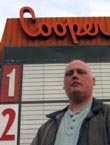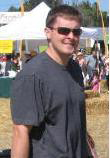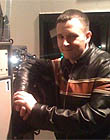|
|
This topic comprises 2 pages: 1 2
|
|
Author
|
Topic: Dawn of the Planet of the Apes
|
|
|
|
|
Sam Graham
AKA: "The Evil Sam Graham". Wackiness ensues.

Posts: 1431
From: Waukee, IA
Registered: Dec 2004
|
 posted 07-13-2014 06:25 PM
posted 07-13-2014 06:25 PM





CINEMA: 13th Avenue Warren, Wichita, KS
AUDITORIUM: 14
PRESENTATION: Dolby Digital Cinema/THX (2D)
PRESENTATION PROBLEMS: None ![[Cool]](cool.gif)
RATING: Three and one half stars (out of four)
THE PLOT: Uh-oh! The hydro plant's down! Wackiness ensues.
Last week, I re-watched the original "Planet of the Apes" for the first time in years, and re-watched "Rise of the Planet of the Apes" for the first time since its theatrical run. The thing that never occurred to me about the original before is that it would have fit right in as a script for the original "Star Trek" TV series. The sets, script, and costumes were right about the same quality. Replace Charlton Heston and his partners with William Shatner, Leonard Nimoy, and DeForrest Kelley, and come up with an end resolution where they all live and leave on the Enterprise, and it would totally work.
The thing I noticed about "Rise"? I liked it better than I remember.
I'll probably like it even better now paired with "Dawn". I was COMPLETELY into this. Every time I thought the plot was going astray, it didn't. It just worked. It looked amazing. Not once did I check the time.
Best "Apes" movie ever.
| IP: Logged
|
|
Geoff Jones
Jedi Master Film Handler

Posts: 579
From: Broomfield, CO, USA
Registered: Feb 2006
|
 posted 07-13-2014 06:52 PM
posted 07-13-2014 06:52 PM





This is what I read:
quote:
Reeves: So I wanted to shoot the film in anamorphic 2.35:1. But we couldn’t do that, because of 3D. Because in 3D the lenses have to match perfectly and they are only now coming up with 3D matched lenses that will allow you to shoot 2.35:1. And the reason I wanted to shoot anamorphic, 2.35:1 was the aspect ratio but also because the depth of field is more shallow, and I think makes for a more intimate and realistic visual approach. And when it turned out that I could not shoot anamorphic, the only way to shoot with the kind of depth of field that I wanted was to shoot in 1.85:1. Because (and this is so technical) but in order to shoot super 35, which is NON-anamorphic, I would have had to have used wider lenses, which would have made for a different kind of depth of field than I wanted. So I shot 1.85:1 so I could get the kind of depth of field that I wanted.
And it would have cost more money, probably, to shoot the film in anamorphic and render the ape effects – it would have been more expensive. And actually no, because they rebuilt everything from the ground up for Ceasar to make it better. WETA sort of makes an overall deal, and tries to give you the best value they can give you, but there were 1,000 artists working on the film, and the overhead for that is basically a small village, so it works out to roughly around somewhere to $50-60,000 per 5 seconds of a shot of apes. Broadly, broadly.
http://www.slashfilm.com/matt-reeves-michael-giacchino-reddit-ama/
| IP: Logged
|
|
|
|
|
|
|
|
|
|
|
|
Terry Lynn-Stevens
Phenomenal Film Handler
Posts: 1081
From: Toronto, Ontario, Canada
Registered: Dec 2012
|
 posted 07-15-2014 12:09 AM
posted 07-15-2014 12:09 AM




Saw it tonight, I liked it, it wasn't great but it was good.
There was something not right with Caesar, he seemed different.
Overall, the first one was better.
quote: Mike Croaro
The 1:85 image doesn't bother me. I've mentioned in the past that I actually prefer it.
Agreed.
quote:
This is what I read:
quote:Reeves: So I wanted to shoot the film in anamorphic 2.35:1. But we couldn’t do that, because of 3D. Because in 3D the lenses have to match perfectly and they are only now coming up with 3D matched lenses that will allow you to shoot 2.35:1. And the reason I wanted to shoot anamorphic, 2.35:1 was the aspect ratio but also because the depth of field is more shallow, and I think makes for a more intimate and realistic visual approach. And when it turned out that I could not shoot anamorphic, the only way to shoot with the kind of depth of field that I wanted was to shoot in 1.85:1. Because (and this is so technical) but in order to shoot super 35, which is NON-anamorphic, I would have had to have used wider lenses, which would have made for a different kind of depth of field than I wanted. So I shot 1.85:1 so I could get the kind of depth of field that I wanted.
And it would have cost more money, probably, to shoot the film in anamorphic and render the ape effects – it would have been more expensive. And actually no, because they rebuilt everything from the ground up for Ceasar to make it better. WETA sort of makes an overall deal, and tries to give you the best value they can give you, but there were 1,000 artists working on the film, and the overhead for that is basically a small village, so it works out to roughly around somewhere to $50-60,000 per 5 seconds of a shot of apes. Broadly, broadly.
http://www.slashfilm.com/matt-reeves-michael-giacchino-reddit-ama/
Or perhaps Matt Reeves thought he was going to get an IMAX release and then Fox bailed on the idea ![[Confused]](confused.gif)
But seriously, Reeves should not have to justify why it was 1.85 and not 2.35.1, it just is and there should be some wonder on our part "the audience" as to why he chose that format. The wonder and awe of going to the movies is diminished when we hear every reason why something was done or when see all the behind the scenes footage. Going to the movies in the 70s, 80s, and most of the 90s was so much better than it is today.
| IP: Logged
|
|
|
|
Lyle Romer
Phenomenal Film Handler
Posts: 1400
From: Davie, FL, USA
Registered: May 2002
|
 posted 07-15-2014 05:46 AM
posted 07-15-2014 05:46 AM




quote: Monte L Fullmer
Heard some crazy buzz that we're gonna see a lot of 1.85:1 releases since the practice of open masking screens is now common, and doing scope features to get a 'letterboxed' presentation on these screens is a very tacky way to present a widescreen feature.
It's like, "you forgot to close the maskings", or "why am I getting a feature that only fills a portion of the screen? Am I being cheated out of my admit ticket?"
Thus, we might be heading back to full circle - going one lens format only so the screens can be filled. (and it will benefit the DMD chips in the projectors since they'll be filled as well and get 1080 HD on the screen).
I haven't seen this film yet but I wanted to throw in my hatred of non masked screens. Especially for common width, scope looks horrible. We saw Edge of Tomorrow recently on one of these screens and my wife (who is the opposite of a videophile) even commented that the screen looks terrible and is distracting and is the reason "people don't like things not to fill the screen at home."
Also, one little technical item. 1:85 doesn't fill the entire DMD chip. The chips are 2048 pixels wide and only use 1998 for flat. I assume in these common width, non masked setups, they are chopping off those 50 pixels in scope. I guess it's not quite as bad as the 80s/90s common width 35mm small screens where there would be masking at least but they'd make 'scope something in the 2.2:1 range or taller by masking the sides.
| IP: Logged
|
|
|
|
|
|
|
|
|
|
All times are Central (GMT -6:00)
|
This topic comprises 2 pages: 1 2
|
Powered by Infopop Corporation
UBB.classicTM
6.3.1.2
The Film-Tech Forums are designed for various members related to the cinema industry to express their opinions, viewpoints and testimonials on various products, services and events based upon speculation, personal knowledge and factual information through use, therefore all views represented here allow no liability upon the publishers of this web site and the owners of said views assume no liability for any ill will resulting from these postings. The posts made here are for educational as well as entertainment purposes and as such anyone viewing this portion of the website must accept these views as statements of the author of that opinion
and agrees to release the authors from any and all liability.
|

 Home
Home
 Products
Products
 Store
Store
 Forum
Forum
 Warehouse
Warehouse
 Contact Us
Contact Us




 Printer-friendly view of this topic
Printer-friendly view of this topic








![[Cool]](cool.gif)



![[Confused]](confused.gif)

![[Wink]](wink.gif)




